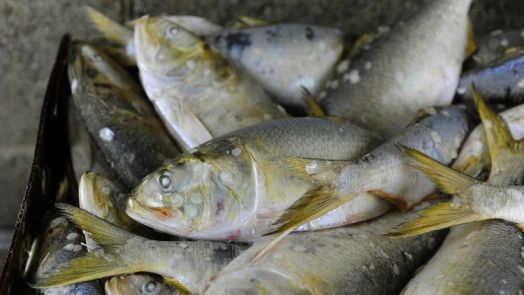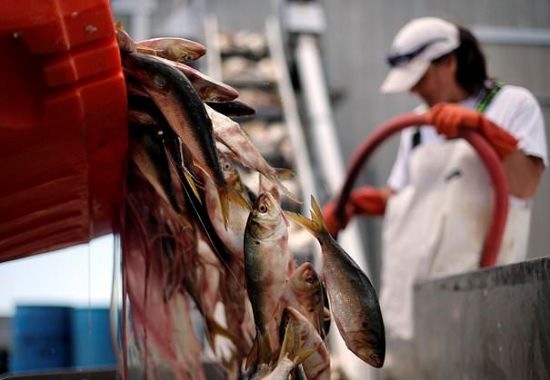Menhaden is a pinch-your-nose kind of fish that even its family, including herring, might like to disown. Practically no one eats menhaden on purpose (unless you are popping omega-3 pills). And, according to legend, Squanto introduced the oily little stinker to hungry Plymouth colonists only as fertilizer for their crops.
Joseph Gordon is senior manager for mid-Atlantic conservation issues for the Pew Charitable Trusts with a scientific interest in preserving the well-being of menhaden fisheries. He answered some questions for The Daily Fray regarding an upcoming vote by the Atlantic States Marine Fisheries Commission that may alter the course of conservation not only for menhaden but potentially other saltwater fisheries.
The issue Nov. 13-14 in Linthicum, Maryland, involves Amendment 3 to the management plan developed by the ASMFC that argues for an ecosystem-wide understanding for menhaden instead of a traditional single-species approach.
● TDF: According to the NOAA, the 2015 benchmark stock assessment, and 2017 update, indicate menhaden are not overfished. So why is Amendment 3 to the Atlantic menhaden FMP such a big deal?
Gordon: The first coastwide menhaden catch limit was put in place in 2013, and in recent years the science shows a significant recovery, primarily off New England. If menhaden are viewed in isolation from other fish and from their environment, you could come to the conclusion that their population is not overfished. However, menhaden are a forage fish, meaning their primary role in the ecosystem is to serve as prey for other marine species. For that reason, scientists increasingly agree that forage fish like menhaden should be viewed from an ecosystem perspective. The right question is: are there enough in the ocean to adequately feed predators and sustain other fisheries? From this perspective, there may not be enough menhaden. A number of their Atlantic predators are in decline in part because of lack of food, and menhaden are no longer abundant through their full historic range. Southern states like Florida have not enjoyed the benefits of a recovery. Amendment 3 will ensure managers are managing them from an ecosystem perspective with these broader goals in mind.

» Related: It's the battle for the bunker
• What do "ecological reference points" mean and are they in place for other species?
We recently did a Q&A with an accomplished fisheries scientist Dr. Ellen Pikitch from Stony Brook University, where she explains this concept in the best way I've seen. Dr. Pikitch says:
"Forage fish should be managed so that their population is high enough to support the predator species that depend on them, as well as fishing. Managers have been using standards, known as reference points, which consider only the fishing part of that equation. But forage fish should be maintained at a higher level than other kinds of fish — as scientists would say, we need a higher population target for forage fish — because they are so critical to the health of other species. And if the population falls below a critically low level, we need to avoid collapse by taking strong and decisive action to reverse declines. The management standards should reflect reality and be based on ecology. This is what scientists mean when they call for ecological reference points."
In other words, while managers use reference points to set catch limits, they are not using ecological reference points yet. Scientists recommend that ecological reference points for a forage fish like menhaden would mean a 75 percent target and a 40 percent threshold. That means the goal would be to sustain a population of menhaden that is 75 percent of what it would be if there were no fishing. Managers would set a catch limit that would provide for a population of that size. If the population were to fall to 40 percent of its unfished level, it would reach the lower bound, or threshold – and fishing would have to cease so that the population could rebuild. This 75 percent target and 40 percent threshold is what scientists conclude is needed to prevent predators from suffering. As scientists study more about menhaden, they could shift the target and threshold with an understanding of tradeoffs between predators and prey, but these general ecological reference points for forage fish can and should be used now.
[The following was in response to a follow-up question:]
While most forage fisheries in the U.S. and around the world are not yet managed on an ecosystem basis, there are some examples of managers using reference points that aim to leave more forage species in the water to fulfill their ecological role as prey. One of our partners, Wild Oceans, explains here:
"The Convention on the Conservation of Antarctic Marine Living Resources (CCAMLR) is generally credited as the first regional body to apply an ecosystems approach to forage fisheries management. Recognizing the key role of krill as forage in the Southern Ocean's ecosystem and that prey species with high predation rates are less resilient to intensive fishing mortality than higher trophic levels, CCAMLR in 1991 adopted more conservative reference points than commonly used in traditional fisheries management. The Antarctic krill policy, sometimes called the 'predator criterion', incorporates the requirements of krill predators (whales, fish, seals, penguins et al) by establishing a level of escapement of 75% of the pre-exploitation (un-fished) biomass, instead of the 40-50% level normally used in single-species management."
 Other major forage fisheries are managed around the world using what are known as "precautionary reference points," which in general seek to maintain higher population sizes than would otherwise be achieved using the default measure used for predator fish, which is "maximum sustainable yield." A few examples include North Sea herring, Icelandic capelin, and Cantabrian Sea anchovy. These precautionary reference points are still focused on the individual target species and the needs of the fisheries that depend upon then, and not upon the needs of their many predators – though the approach is headed in the right direction.
Other major forage fisheries are managed around the world using what are known as "precautionary reference points," which in general seek to maintain higher population sizes than would otherwise be achieved using the default measure used for predator fish, which is "maximum sustainable yield." A few examples include North Sea herring, Icelandic capelin, and Cantabrian Sea anchovy. These precautionary reference points are still focused on the individual target species and the needs of the fisheries that depend upon then, and not upon the needs of their many predators – though the approach is headed in the right direction.
The ASMFC can build on advances around the world and make history by applying the best ecosystem-based approach to the largest fishery on the U.S. east coast and one of the biggest on the planet. This would set a broader precedent as one of the first and largest-scale fisheries to put into practice the scientific guidelines for "low trophic level species" established by the Marine Stewardship Council. The ASFMC's decision could have an impact on other forage species on the East Coast; the New England Fishery Management Council is considering a similar approach for Atlantic herring and a decision is expected next year.
● TDF: What kind of offshore forage fish industry exists in Florida?
Gordon: While large-scale menhaden processing plants once existed as far south as Fernandina Beach, now the only major “reduction” plant for menhaden is outside of Florida, in Reedville, Virginia. The remaining commercial fishery for menhaden in Florida focuses on catching them to use as bait for other fisheries. Florida fishermen use cast nets in inshore and nearshore waters, and offshore, a limited group of fishermen use purse seine nets in the Gulf of Mexico to catch a diverse array of forage fish and lampara nets in the Florida Keys to catch ballyhoo. Florida's portion of the East Coast-wide menhaden quota is 78,449 pounds: .02 percent of the overall 2017 quota of 440,924,524 pounds.
● Where do forage fishes rank on Florida's conservation radar?
Florida's ASMFC representatives have voted for conservation in past decisions about appropriate catch limits and when they supported the development of Amendment 3, including ecological reference points. The Florida Fish and Wildlife Conservation Commission, which has a representative on the ASMFC, has been a leader in forage fish management. The FWC recognizes the importance of forage fish to Florida's marine ecosystems, which shows up in its management of commercial fishing on mullet and ballyhoo, two forage fish species, and by its tracking of the catch of other forage fish in its annual Status and Trends Reports. Their reports indicate that state-managed forage fish populations are generally stable. They're working to learn more about forage fish and their relationship to predators through the Florida Forage Fish Research Program (FFFRP).
The FFFRP is a public-private partnership between FWRI, leading academic institutions, and non-governmental organizations designed to provide Florida much needed analysis of existing data and real world experience for the next generation of marine scientists. Once a year, the program provides fellowships to graduate students to work hand in hand with FWRI to answer some of the most pressing questions regarding forage fish and their relationship to Florida's marine habitats and predators. This modest investment will provide lasting rewards for coastal businesses, fishery managers, resource users, and Florida's taxpayers.
● What's at stake in Florida?
If the ASMFC adopts Option E and moves forward with a modern approach to managing menhaden, Floridians will see menhaden increasing in the waters off our shores. The benefits would be both economic and environmental for Florida – a healthier marine ecosystem that provides us with better fishing, diving, birding, and with growth in tourism that would follow that.
» Photos via Associated Press.
» 5=Q&A appears periodically in The Daily Fray, spotlighting people, issues, places, and things. Comments: editor@thedailyfray.com.
Outside
Bitcoin mining emissions in China will hit 130 million tonnes by 2024 https://t.co/w6He7so8N2 pic.twitter.com/qYUDtBdeRK
— New Scientist (@newscientist) April 9, 2021
The Gunk Report
For the Blue-Green Algal Bloom Weekly Update from the Florida Department of Environmental Protection, tap here. For DEP's Algal Bloom Sampling Map, tap here.
What, me worry?
» "PLAYING WITH SHARKS," which recently premiered at the Sundance Film Festival, documents diving legend Valerie Taylor.